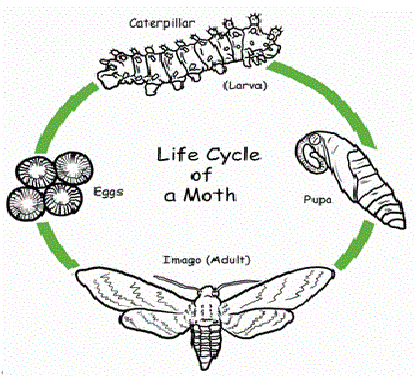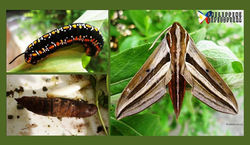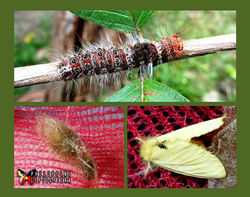PHILIPPINE
LEPIDOPTERA
Moth Life Cycles
Moths have fascinating life-cycles that are used in many countries to teach children about the natural world. The transformation from egg to caterpillar to pupa is one of the wonders of nature.

1. All moths start off as eggs. Some eggs are smaller than a millimeter and almost all are yellow or green.
2. A caterpillar once it hatches often eats its own eggshell and then begins to eat the plant it was laid on. Caterpillars must molt or shed their own skin in order to grow. Most do this 4 to 5 times in a period of about 2 weeks.
3. A fully grown caterpillar finds a safe place to pupate. Some caterpillars spin cocoons of silken threads in which they pupate.
4. Inside the caterpillar is undergoing amazing chemical changes, and gradually the adult moth emerges.
5. The adult moth breaks out of its pupa. Its wings and body are still soft so it pumps blood into its newly formed wings. Within about half an hour, the exoskeleton hardens and the wings become rigid. The new adult's task is to find a mate.

In one day, a caterpillar can eat many times its weight in food. Most of the food is stored as fat for later stages of life, such as the metamorphosis from caterpillar to adult. During that time the moth can't eat.
 LORQUIN'S ATLAS MOTH, Attacus lorquinii (Saturniidae; Saturniinae) © Shekai Alaban |  OLEANDER HAWK MOTH or ARMY GREEN MOTH, Daphnis nerii (formerly Deilephila nerii) (Sphingidae; Macroglossinae) © Leana Lahom-Cristobal |
|---|---|
 GREEN HAWK MOTH, Pergesa acteus (Sphingidae; Macroglossinae) © Romana Pahilanga Delos Reyes |  TUSSOCK MOTH, Unidentified Orgyiini (Erebidae; Lymantriinae; Orgyiini) © Leana Lahom-Cristobal Host plant: "Duhat (Syzygium cumini) |
 HAWK MOTH, Eupanacra elegantulus (Sphingidae; Macroglossinae) © Linda Alisto, Rey M. Abellada & Albert Kang |  TUSSOCK MOTH, Unidentified Orgyiini (Erebidae; Lymantriinae; Orgyiini) © Linda Alisto Host plant: Golden Duranta (Duranta repens) |
 TIGER MOTH, Olepa sp. (Erebidae; Arctiinae; Spilosomini) © Shekai Alaban |  EREBID MOTH, Macaldenia cf. palumba (Erebidae; Erebinae; Poaphilini) © Arlene Halabaso Host Plant: Calamansi (Citrofortunella microcarpa) |
 SLUG MOTH, Griseothosea sp. (Limacodidae; Limacodinae) © Romana Pahilanga Delos Reyes |  IMPATIENS HAWK MOTH, Theretra oldenlandiae (Sphingidae; Macroglossinae) © Romana Pahilanga Delos Reyes |
 LAPPET MOTH, Odonestis sp. (Lasiocampidae; Pinarinae) © Leana Lahom-Cristobal |  PANTROPICAL MOTH, Birthana basiflava (Immidae) © Linda Alisto Host plant: Maki Yew Pine (Podocarpus macrophyllus) |
 LUNA GYPSY MOTH, Lymantria lunata (Erebidae; Lymantriinae; Lymantriini) © Leana Lahom-Cristobal |  ZYGAENID MOTH, Thyrassia philippina (Zygaenidae; Procridinae) © Choco Voices & Leana Lahom-Cristobal |
 CASTOR SEMI-LOOPER MOTH, Achaea janata (Erebidae; Erebinae) © Romana Pahilanga Delos Reyes |  TUSSOCK MOTH, Unidentified Orgyiini (Erebidae; Lymantriinae; Orgyiini) © Leana Lahom-Cristobal Host plant: Lantana camara |
 HAWK MOTH, Eupanacra elegantulus (Sphingidae; Macroglossinae) © Linda Alisto & Rey M. Abellada |  TUSSOCK MOTH, Nygmia sp. (Erebidae; Lymantriinae; Nygmiini) © Linda Alisto Host plant: Begonia |
 COTTON LOOPER, Anomis flava (Erebidae, Scoliopteryginae, Anominae) © Romana Pahilanga Delos Reyes |  LAPPET MOTH, Estigena (Gastropacha) sp. (Lasiocampidae; Pinarinae) © Leana Lahom-Cristobal |
 TUSSOCK MOTH, Nygmiini (Erebidae; Lymantriinae; Nygmiini) © Romana Pahilanga Delos Reyes |  CUP MOTH or SLUG MOTH, Unidentified Limacodinae (Limacodidae; Limacodinae) © Linda Alisto Host plant: Coffea arabica |
 CUP MOTH or SLUG MOTH, Unidentified Limacodinae (Limacodidae; Limacodinae) © Linda Alisto |  LAPPET MOTH, Paralebeda sp. (Lasiocampidae) © Linda Alisto |
 PANTROPICAL MOTH, Moca sp. (Immidae) © Linda Alisto |  TUSSOCK MOTH, Nygmiini (Erebidae; Lymantriinae; Nygmiini) © Romana Pahilanga Delos Reyes |
 EGGAR, Suana sp. (Lasiocampidae) © Linda Alisto |  EUTELIID MOTH, Targalla sp. (Euteliidae; Euteliinae) © Leana Lahom-Cristobal |
 LILY CATERPILLAR MOTH, Spodoptera picta (Noctuidae; Noctuinae; Prodeniini) © Shekai Alaban |  NOCTUID MOTH, Condica sp. (Noctuidae; Condicinae; Condicini) © Romana Pahilanga Delos Reyes |
 EREBID MOTH, Platyja sp. cf. umminia (Erebidae; Erebinae) © Romana Pahilanga Delos Reyes |  TARO HAWK MOTH, SILVER-STRIPED HAWK MOTH or VINE HAWK MOTH, Hippotion celerio (Linnaeus, 1758) synonym: Sphinx tisiphone. (Sphingidae; Macroglossinae) © Romana Pahilanga Delos Reyes |
 MARBLED WHITE MOTH, Nyctemera coleta (Erebidae; Arctiinae; Arctiini) © Shekai Alaban |  CRAMBID MOTH, Herpetogramma Stultalis (Crambidae; Spilomelinae) © Romana Pahilanga Delos Reyes |
 LOBSTER MOTH, Stauropus sp. (Notodontidae; Heterocampinae) © Shekai Alaban |  CROTALARIA MOTH, Utetheisa lotrix (Erebidae; Arctiinae) © Romana Pahilanga Delos Reyes |
 EREBID MOTH, Thyas coronata (Erebidae; Erebinae; Catocalini) © Romana Pahilanga Delos Reyes |  EREBID MOTH, Mocis undata (Erebidae; Erebinae) © Shekai Alaban |
 EREBID MOTH, Buzara sp. cf. onelia (Erebidae; Erebinae) © Joy Valencia Villafuerte-Hafalla |  EREBID MOTH, Bastilla joviana (Erebidae) © Shekai Alaban |
 CRAMBID MOTH, Nacoleia insolitalis (Crambidae; Spilomelinae) © Shekai Alaban |  AILANTHUS SILKMOTH, Samia luzonica (Saturniidae; Saturniinae) © Shekai Alaban |
 TUSSOCK MOTH, Unidentified Nygmiini (Erebidae; Lymantriinae; Nygmiini) © Romana Pahilanga Delos Reyes |  ZYGAENID MOTH, Unidentified Zygaenidae (Zygaenidae) © Linda Alisto |
 TIGER MOTH, Aloa sp. (Erebidae; Arctiinae) © Evelyn Mendez |  SLUG MOTH, Thosea sp. (Limacodidae; Limacodinae) © Romana Pahilanga Delos Reyes |
 TIGER MOTH, Olepa sp. (Erebidae; Arctiinae; Spilosomini) © Jolly Ibañez |  EREBID MOTH, Anomis sp. (Erebidae; Erebinae; Scoliopteygini) © Arlene E. Halabaso |
 CRAMBID MOTH, Omiodes sp. (Crambidae; Spilomelinae) © Romana Pahilanga Delos Reyes Host plant: Indian Tree |  EREBID MOTH, Platyja sp. (Erebidae; Erebinae) © Jun Iriarte |
 GUAVA MOTH, Ophiusa disjungens (Erebidae; Erebinae; Ophiusini) © Arlene E. Halabaso |